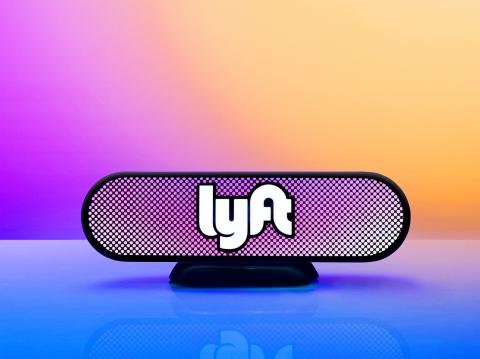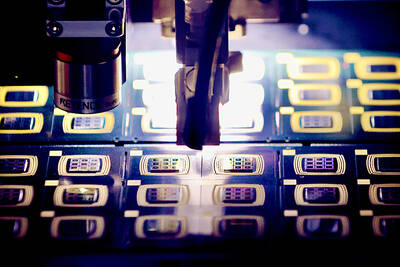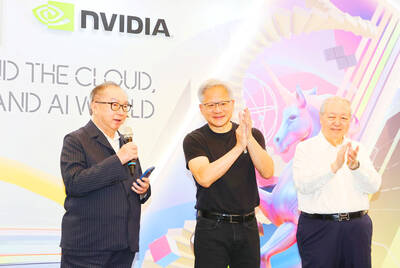In an advertisement, three executives in black suits sit in black chairs in a black room, plotting against ride-sharing startup Lyft Inc.
“We’ve got to slow them down. How are we going to do it?” one executive asks.
“Spike strips?” his colleague says.

Photo: AP
The words “Ride Corp” hang behind them. However, you know what company they really work for.
This is one of four 30-second ads that Lyft plans to roll out on cable and network TV this year. The campaign is also to run on buses and in New York City’s Times Square.
The company would not say how much it is spending on the ads. However, one thing is for sure: It puts US ride-hailing leader Uber Technologies Inc in the crosshairs.
“We know that passengers prefer Lyft,” said Tali Rapaport, the San Francisco-based company’s head of product. “We also know that passengers have a choice.”
Uber and Lyft are fighting for market share in the US. After Lyft started making gains at the beginning of the year, Uber cranked up spending. The company lost US$100 million in the US in the second quarter, while Lyft promised investors earlier this year to keep its monthly spending at less than US$50 million.
Lyft’s new ad campaign suggests the war between the two could come down to marketing as much as anything else. The two companies have long competed by undercutting each other on price and improving how quickly they pick up riders.
Today, both companies realize their brands can win customers, too.
Uber hired former Target Corp chief marketing officer Jeff Jones as president of its ride-sharing business.
In his first public statement since taking the job, Jones wrote in a post on LinkedIn on Monday that his first priority is helping drivers.
“Uber will do a much better job listening to drivers and serving their needs,” Jones said.
While Jones tries to improve Uber’s relationship with its drivers, Lyft is seizing on its competitor’s sometimes cold, corporate reputation.
In one ad, a callous executive asks: “Why are all the Lyft drivers so happy?”
His colleague says: “Maybe it’s because Lyft lets passengers tip them in the app.”
A third executive says: “They use the extra money to buy gifts for their family.”
All three “Ride Corp” executives burst into cackling laughter.
The screen says: “Lyft, US$100 million tips and counting.”
Uber does not let riders tip their drivers in its app and Lyft does.
Lyft also said it is phasing out its glowing pink mustache in-car symbol and replacing it with an oval-shaped device called an “Amp” with the company’s name on it.
The device displays different colors to help riders find their car more easily. Lyft plans to ship Amps to drivers in San Francisco, Las Vegas and Los Angeles by New Year’s Eve.
Lyft said it will cover the cost, but declined to disclose how much it was paying to make the Amp.
Uber has in the past asked Lyft drivers to “Shave the ‘Stache” and switch over to working for Uber.
Now Lyft is making the cut itself.
“The mustache was an incredible relic,” Rapaport told reporters in San Francisco.

AI SERVER DEMAND: ‘Overall industry demand continues to outpace supply and we are expanding capacity to meet it,’ the company’s chief executive officer said Hon Hai Precision Industry Co (鴻海精密) yesterday reported that net profit last quarter rose 27 percent from the same quarter last year on the back of demand for cloud services and high-performance computing products. Net profit surged to NT$44.36 billion (US$1.48 billion) from NT$35.04 billion a year earlier. On a quarterly basis, net profit grew 5 percent from NT$42.1 billion. Earnings per share expanded to NT$3.19 from NT$2.53 a year earlier and NT$3.03 in the first quarter. However, a sharp appreciation of the New Taiwan dollar since early May has weighed on the company’s performance, Hon Hai chief financial officer David Huang (黃德才)

The Taiwan Automation Intelligence and Robot Show, which is to be held from Wednesday to Saturday at the Taipei Nangang Exhibition Center, would showcase the latest in artificial intelligence (AI)-driven robotics and automation technologies, the organizer said yesterday. The event would highlight applications in smart manufacturing, as well as information and communications technology, the Taiwan Automation Intelligence and Robotics Association said. More than 1,000 companies are to display innovations in semiconductors, electromechanics, industrial automation and intelligent manufacturing, it said in a news release. Visitors can explore automated guided vehicles, 3D machine vision systems and AI-powered applications at the show, along

FORECAST: The greater computing power needed for emerging AI applications has driven higher demand for advanced semiconductors worldwide, TSMC said The government-supported Industrial Technology Research Institute (ITRI) has raised its forecast for this year’s growth in the output value of Taiwan’s semiconductor industry to above 22 percent on strong global demand for artificial intelligence (AI) applications. In its latest IEK Current Quarterly Model report, the institute said the local semiconductor industry would have output of NT$6.5 trillion (US$216.6 billion) this year, up 22.2 percent from a year earlier, an upward revision from a 19.1 percent increase estimate made in May. The strong showing of the local semiconductor industry largely reflected the stronger-than-expected performance of the integrated circuit (IC) manufacturing segment,

NVIDIA FACTOR: Shipments of AI servers powered by GB300 chips would undergo pilot runs this quarter, with small shipments possibly starting next quarter, it said Quanta Computer Inc (廣達), which supplies artificial intelligence (AI) servers powered by Nvidia Corp chips, yesterday said that AI servers are on track to account for 70 percent of its total server revenue this year, thanks to improved yield rates and a better learning curve for Nvidia’s GB300 chip-based servers. AI servers accounted for more than 60 percent of its total server revenue in the first half of this year, Quanta chief financial officer Elton Yang (楊俊烈) told an online conference. The company’s latest production learning curve of the AI servers powered by Nvidia’s GB200 chips has improved after overcoming key component